
New Zealand’s North Island: Rotorua or Hades? Shire or Sheep Farm? And Is Auckland Shut or Open?
We were young and stupid.
Little did we know that life cost money, so we said ‘sure’ when offered a spot in a 1991 Auckland teacher exchange program. Almost-newlyweds with a blended family of typical teenagers (lots of scowls and secrets), we barely paid the bills as it was. I mean, Why NOT take a somewhat impromptu trip to New Zealand, way Down Under?

We kicked off our married life with a magical two-week Ireland honeymoon, so it figures that we signed on for our next grand adventure as soon as we could manage it (or not), despite the restrictions of our demanding mid-career lives. Seems we’re not the folks Bilbo described before his Hobbit journey: “Hobbits are plain quiet folk and have no use for adventures. Nasty disturbing uncomfortable things! Make you late for dinner! I can’t think what anybody sees in them.”
I reread J.R.R. Tolkien’s quest tale, The Hobbit, in preparation for our second visit to New Zealand, 28 years after that first one (which we eventually paid for but I’m not sure how). Ever since Sir Peter Jackson used New Zealand as the backdrop for his Lord of the Rings and Hobbit films, the country’s second name has been ‘Middle Earth’ and we’ve wondered how all that fame impacted the gorgeous countryside we remember. And how had all that time transformed the two of us? Do we still sign up for journeys when we’re not sure how we’ll pay for it all? (duh). Have we learned anything new? (oh yes). Did those surly teenagers grow up ok? (mostly, and they even smile now!).

At the end of The Hobbit Bilbo returned to the Shire transformed, changed forever by his grand adventure. And spoiler alert – he survived all the Tolkien tales, even though word had it that Jackson really wanted to kill off a hobbit somewhere along the way. We survived as well, and now our 30-year wedding anniversary is coming up – that’s a serious chunk of time in any life journey. So as the Golden Princess sailed into our first port on the North Island we pondered how things had changed, for New Zealand as well as ourselves over all these years.
I found the wonderful tour outfit Cruise Tours Tauranga for our Tauranga port stop, who agreed to take us on a 10-hour driving tour so we could visit both Rotorua and Hobbiton in one day (and return shipside before sailaway – hey we can be practical sometimes). The long day made for serious road time, just like our driving tours 28 years ago did, when we remember dodging sheep and newborn lambs in the lush rolling farming country near today’s Hobbiton movie site. We wondered if strip malls had invaded due to all those rabid Tolkien fans. And was Rotorua still the astonishing geothermal wonderland we remembered, where even our private hotel hot tub bubbled away with super-heated sulfer water?
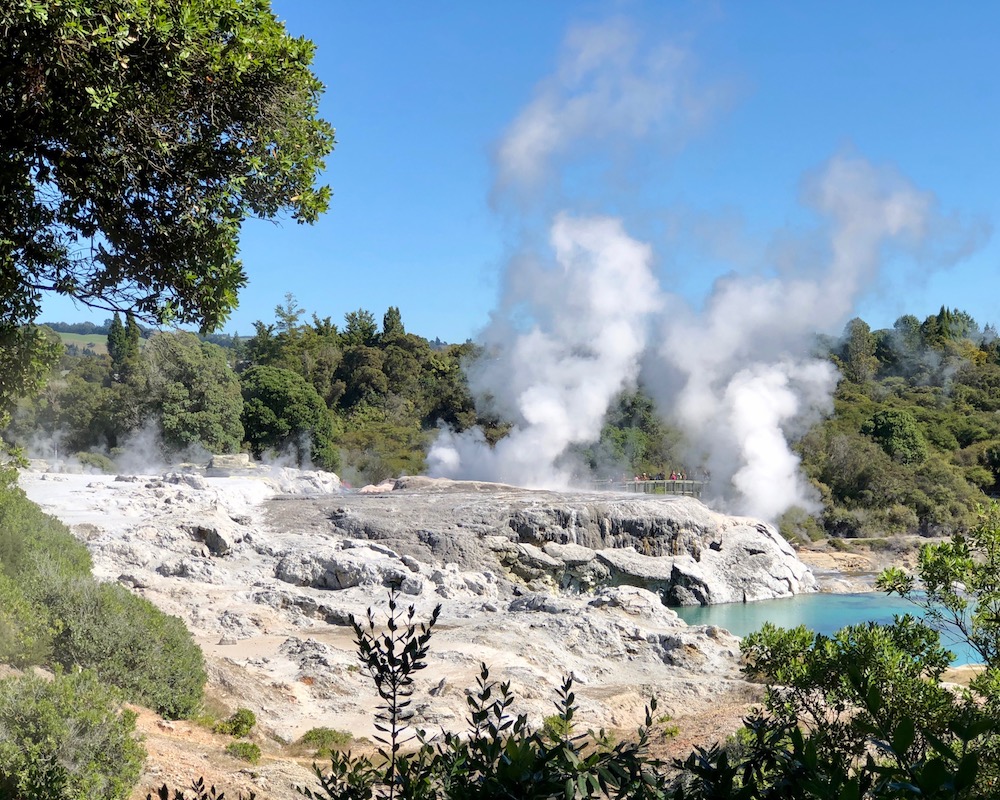
On Cruise Critic we found nine other hardy souls up for our driving marathon, and disembarked to drive through American-generic strip mall-dotted suburbs (sad face) between Tauranga and Rotorua. Tourists crawled everywhere, but back then we seemed to be the only tourists in town. That was July, though, deep in New Zealand’s winter, and long before cruise ships hit the big time. So maybe Rotoura empties out once all the cruisers sail off to Alaska or wherever.

Our hot tub hotel, Malone’s, still sits proudly on Rotorua’s main drag, joined by rows of generic hotels, McDonald’s, Starbucks, all the usual chain stuff. Expansive parklands along Lake Rotorua still offer stunning views with meandering walking pathways everywhere, even though the well-regarded Rotorua Museum of Art & History is closed due to recent earthquake damage. We gazed over the lake to Mokoia Island, where Hinemoa, the daughter of an influential chief, followed the sound of her forbidden lover’s flute to the island for a secret reunion (true story). We also heard tales of distraught maidens pitching themselves into boiling cauldrons to escape abusive relationships. The former site of the pink-and-white Rotomahana Terraces still slumps on the hillside, where the terraces were swallowed up by Mt. Tarawera’s 1886 eruption that also buried an entire village. Makes you wonder what might be swallowed up next.
I suppose you could conclude that Rotorua is as awful as George Bernard Shaw made it sound after his 1934 visit when he said, “I was pleased to get so close to Hades and be able to return.” Lots of scalding steaming pits, and that rotten-egg smell of hydrogen sulfide hangs in the air. But Rotorua’s like nothing else we’ve seen in the world, except maybe Yellowstone National Park, and we still love the place, sulfer smell and all. Back in 1991, we navigated rickety geyser walkways at Whakarewarewa, or Whaka as the locals call it, which took you dangerously close to the spectacular roaring geysers spewing super-heated sulphur water.
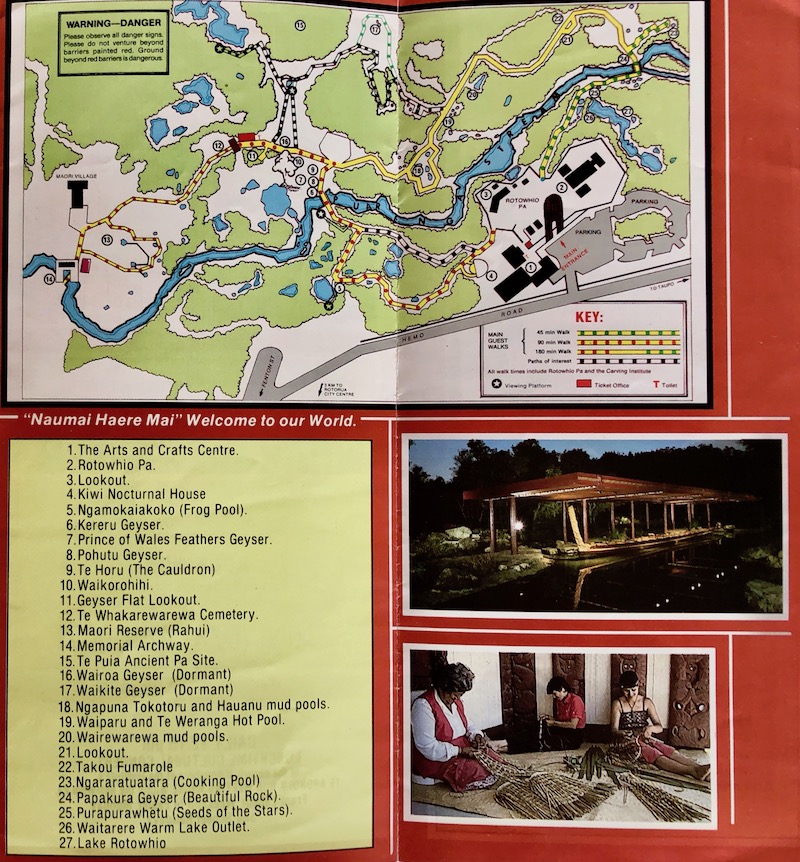

Today, Whaka has been split into two sites due to tangles between Maori tribes and government, both clinging to their slice of the income-producing tourist pie. Modern safety precautions have the place buttoned down, but steam still wafts over cauldrons of boiling mud, and off in the distance geysers fling that superheated water skyward, same as they always have. We stuck with the Maori-run side this time, The Maori Living Village, for a Maori cultural tour featuring a chest-thumping, eye-bulging Haka warrior dance and a delicious hangi lunch of chicken and vegetables, cooked in the bubbling waters of a nearby scalding cauldron.


Whaka seems pretty much the same, despite the split-screen tourist sites. Our Maori tour guide shared how the twin sites have been incorporated into their lives, since her own daughter works at the other site – she said that they wave to each other sometimes across the geyser field. So the Maori villagers who live here have carried on pretty much as they always have, despite time’s alterations.

As we headed toward Hobbiton, Jackson’s movie set-turned tourist attraction, we finally found the pastoral New Zealand countryside we so fondly remembered. No wonder Jackson took one look at Alexander’s 1250-acre sheep and cattle farm from his helicopter and recognized it as the perfect setting for some hobbit holes. No strip malls in sight, just sheep, cattle, and stupendous panoramas.

In 1998 when Jackson filmed scenes for the Lord of the Rings trilogy, he built set structures out of temporary materials. After the movies aired passionate Tolkien fans invaded the farm, traipsing over hillsides seeking out the old sets. So when designers rebuilt everything for The Hobbit films they made the Shire’s structures permanent, planning to convert it into a tourist venue.
While it’s still a working farm, the ‘tourist venue’ part is now reality, and wow – what a venue. Do make sure to secure Hobbiton Movie Set reservations well in advance, since those who show up hoping to buy day-of tickets will be turned away – this place is beyond popular, and rightly so. People in our tour group literally gasped when we turned a garden corner to view the Shire hillside, where Hobbiton’s 39 hobbit holes sit.
Except that the captivating hobbit exteriors we see in the films are merely facades, interior scenes shot elsewhere, much to the disappointment of some Hobbiton visitors. I caught a bit of one film on our cabin tv last night – the lavish movie interior of Bilbo’s hobbit hole was nothing like the dark dirt cave of the ‘real’ one we peeked in. But I prefer the Alexander sheep farm hobbit holes, by far – I could sit on the stoop of one of those all day every morning of my life, watching the sun come up.
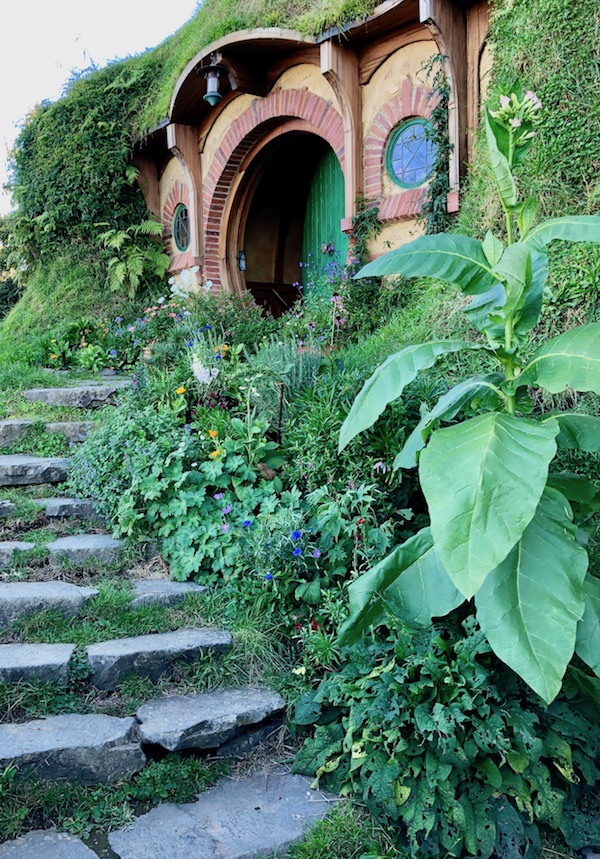
But I couldn’t watch the sun set from there, in fact, since Hobbiton’s hillside faces east, not west. This proved problematic during Hobbit filming, since in the final scene Gandalf and Bilbo sit outside Bilbo’s hobbit home, smoking pipes and watching the sun set. But problem solved: film the scene at sunrise, and just pretend you’re watching the sun sink. So yep, you’re looking at a rising, not setting sun in the film. But nobody cares. Hey, it’s Hollywood – and dedicated Tolkien fans are ok with that ‘suspend your disbelief’ thing.

Our Hollywood-ready guide also captivated us with a real-life story about one of the last scenes in The Return of the King, as we stood outside Sam Gamgee’s hobbit hole home. When Sam returns home triumphant to be greeted by his wife Rosie and their children, those children were actually the real-life children of actors Sean Aslin (Sam) and Sarah McLeod (Rosie). Sarah’s daughter played Frodo Gamgee, in fact, and wore a blue cap to disguise her real gender. Since the actors had been separated from their children due to filming demands, their emotional reactions captured on camera were more real than not, just as Jackson intended.

On my 2019 reread, I did note the absence of any significant female characters in the Hobbit, but don’t remember having any trouble identifying with Bilbo Baggins as a young girl. In my mind, I was just ordinary like Bilbo, someone who maybe someday might do great things too! Didn’t matter that Bilbo was a man (or hobbit, or whatever). But hey – I also loved Gollum, Tolkien’s shambling slimy fish-monster and one of the greatest villains of all time, right up there with Richard III and Darth Vader.

I looked for Gollum merch at the gift shop, but all I found was a tacky Gollum pillow cover -rather sad, just like Gollum. I do try to stay far away from any real-life Gollums, but Tolkien’s Gollum captivated me. He’s so destructively evil, he’s driven everyone who ever loved him away, and he’s so lonely. In fact, Andy Seris, the man who played Gollum in the films, based Gollum’s desperation for his ‘preciousss’ ring on the cravings and pain of drug addicts. Tolkien describes him as a creature who lives “endless unmarked days without light or hope or betterment.” I did come to pity Gollum just as Bilbo did, but I wouldn’t trust him (or any other real-life Gollums) past my little pinkie finger, not ever.
We’ve definitely learned who not to trust over all these years, from drug addicts to dragons, and we’ve also lost some things we’re not at all sad to have lost, including that anxious ambition younger folks seem to wear on their faces. Time tends to cure most everyone of that, at least the people we’ve been meeting in our travels. Unless of course you call seeing all seven continents ‘ambition’ which I don’t: I call that ‘travel’. Time has taught us to be content with whatever the day brings, and if we lose track of time in the middle of the ocean as the seas slip past outside, so be it.

We also have a new appreciation for one of Gollum’s riddles:
What is…..
This thing all things devours:
Birds, beasts, trees, flowers;
Gnaws iron, bites steel;
Grinds hard stones to meal;
Slays king, ruins town;
And beats high mountains down.
Bilbo saved himself by accident when he asked Gollum to give him more TIME! to solve the riddle. The answer, of course, was time, but Gollum’s distinctly negative view on time is, well – so bleakly Gollum. In the 28 years since we visited New Zealand last, time has certainly had its way with us, devouring our youth and spiriting away so many of our loved ones. Yet it has also provided new joys, new peace, and valuable insights into what truly matters. And time does not always ruin towns – take Auckland as a perfect example.
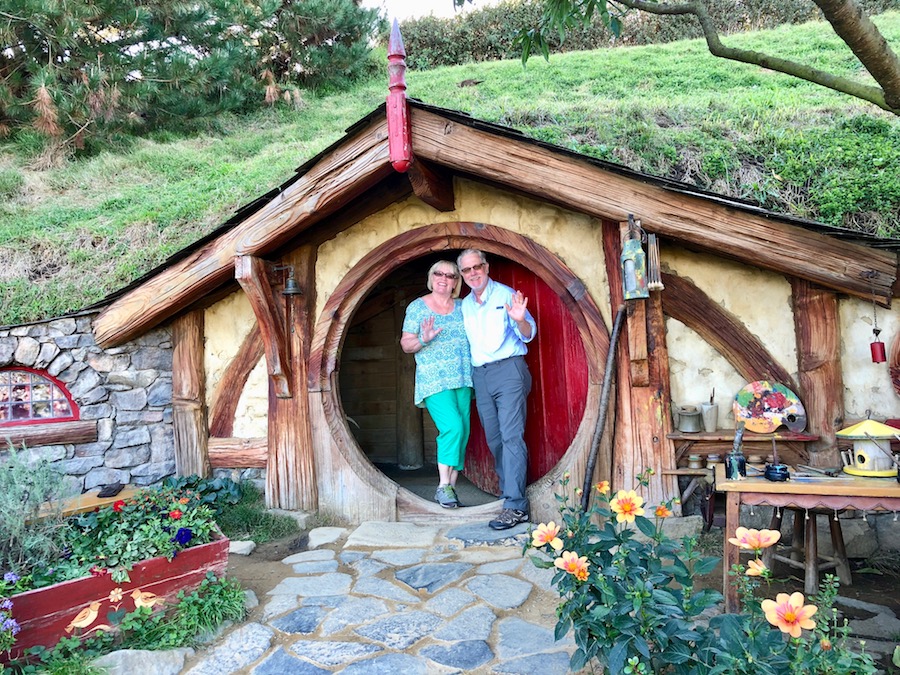
We spent most of our 1991 visit in New Zealand’s largest city, and back then it seemed eerily deserted. One writer said he couldn’t tell you his opinion of the place, because it was shut when he visited – that’s about right. Now, though, it’s definitely open, hopping with cruise passengers strolling the new Viaduct Harbor area, with a distinctly Asian vibe. There have been significant Chinese investments in the city recently, and Asian-oriented businesses populate every street. While Kiwis express some unease with all the foreign influence, they also celebrate New Zealand’s modern multiculturalism, with close to 30% of the population being of Polynesian descent.
A Seattle Space Needle imitator, the Skytower, hovers over Auckland’s rapidly growing skyline. And the 1912 neoclassical Ferry Building we remember still sits proudly front and center, just as it did 28 years ago, greeting hordes of cruise passengers when they disembark.

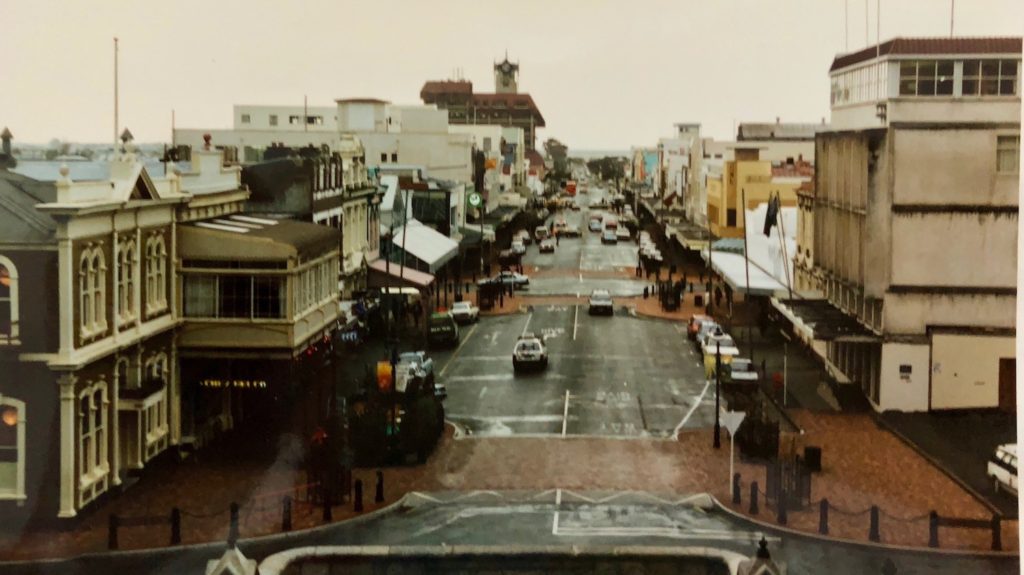
We enjoyed a free walking tour with our delightful Walk With Me guide (you just pay an appropriate tip), who brought Auckland’s canyon-like city streets to life through fascinating historical details and human interest stories. She also emphasized New Zealand’s pride-of-place as the first nation in the world to grant women the vote, in 1893 – yay New Zealand! And we bowed down to Sir Peter Blake’s Black Magic sailing yacht at Auckland’s Maritime Museum, since it wrested yachting’s most prestigious prize from the Americans for the first time in the race’s 144-year history in 1995. Auckland offers plenty more that we just didn’t have time to see, so Auckland seems to be doing just fine today. And so are we, after all these years.
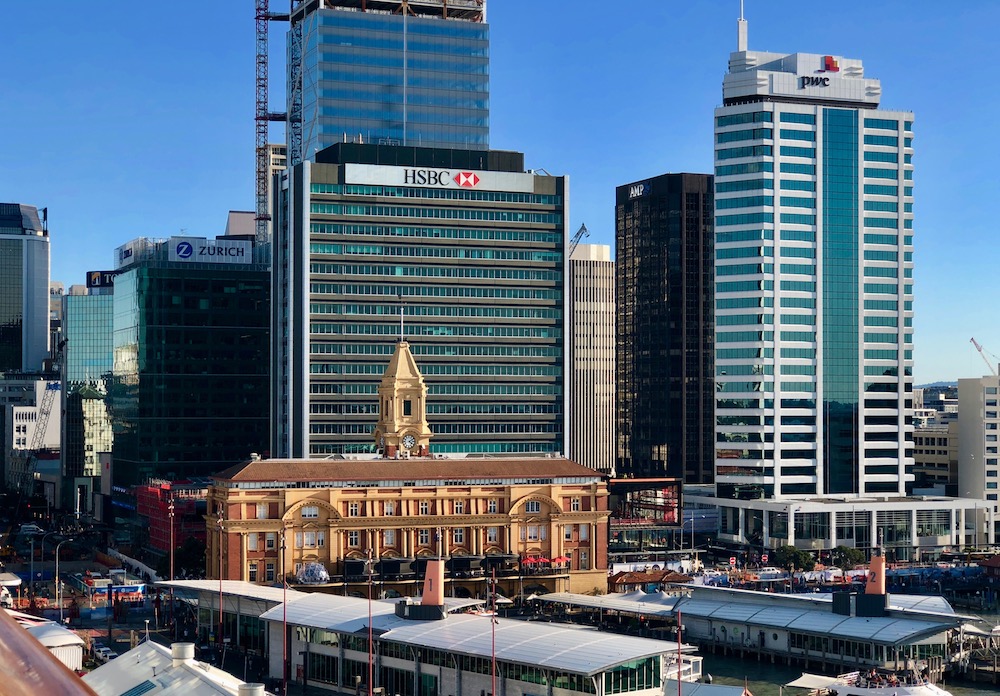
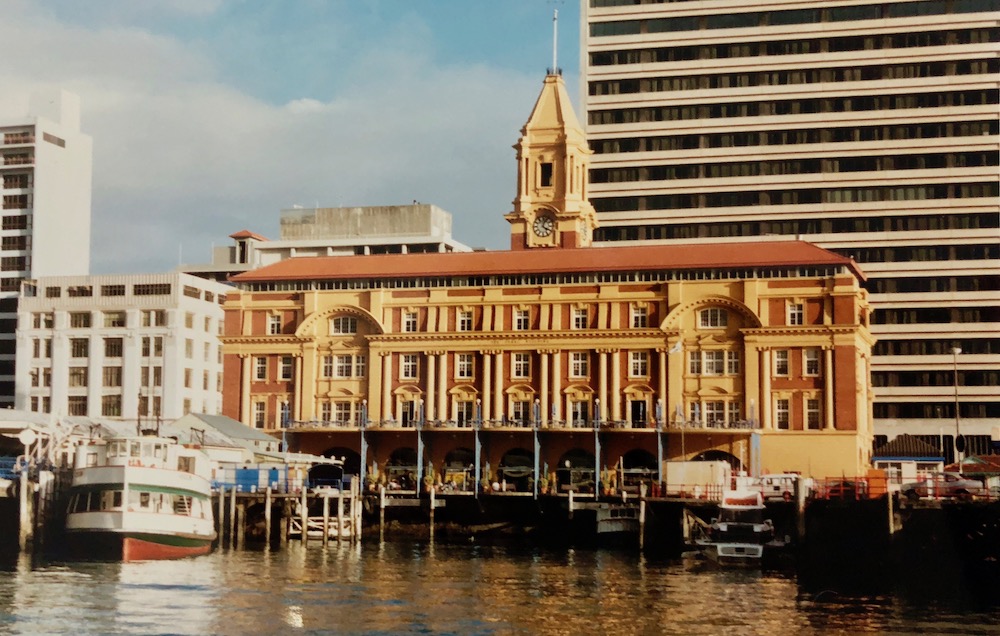
Ok, I just can’t resist more Tolkien, to wrap things up. As Bilbo puzzles over his options when the journey seems impossible, he asks: “Go back? No good at all. Go sideways? Impossible. Go forward? …Do we really have to go through?” he asks Gandalf with a groan.
And what perfect life advice Gandalf gives him:
“Yes you do,” said the wizard. “if you want to get to the other side. You must either go through or give up your quest….. There are no safe paths in this part of the world. Remember you are over the edge of the Wild now, and in for all sorts of fun wherever you go….keep your spirits up, and hope for the best!”

And that’s about how it’s gone pretty much, since 1991. Back then we didn’t know if we’d make it or how it all would all turn out. But we did reach the ‘other side’ in a way, and we’ve had all sorts of fun, just as Gandalf promised, wherever we’ve been.

….and what’s really cool – this time we have cruise cards.
Who would have ever thought?
Thanks as always for following along, keep your spirits up, and hope for the best, everyone!


